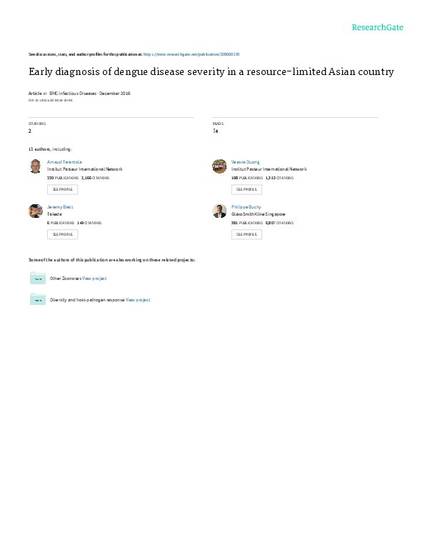
Article
Early diagnosis of dengue disease severity in a resource-limited Asian country
BMC Infectious Diseases
(2016)
Abstract
Background: Dengue is endemic throughout Cambodia, a country faced with significant health and economic challenges. We undertook a clinical study at the National Paediatric Hospital in Phnom Penh to evaluate clinical diagnostic parameters for dengue and predictors of disease outcome. Methods: Between September 2011 and January 2013, all consecutive inpatients aged between 1 and 15 years and presenting with suspected dengue were enrolled. They were clinically assessed using both the 1997 and 2009 WHO dengue classifications. Specimens were collected upon admission and discharge and tested for dengue at Institut Pasteur in Cambodia. Results: A total of 701 patients were screened. Of these, 79 % were dengue-confirmed by laboratory testing, and 21 % tested dengue-negative. A positive tourniquet test, absence of upper respiratory symptoms, leukopenia, thrombocytopenia, and elevated liver transaminases were independent predictors for laboratory-confirmed dengue among the children. The presence of several warning signs on hospital admission was associated with a concurrent laboratory-confirmed diagnosis of severe disease outcome. Conclusions: The presence of two or more warning signs was associated with a concurrent laboratory-confirmed diagnosis of severe dengue at hospital admission. Thus, a cumulative score combining simple clinical parameters and first-line laboratory findings could be used to accurately predict dengue virus infection in pediatric populations, optimizing triage in settings with limited laboratory resources.
Disciplines
Publication Date
2016
DOI
https://doi.org/10.1186/s12879-016-1849-8
Citation Information
Philippe Cavailler, Arnaud Tarantola, Yee Sin Leo, Andrew A. Lover, et al.. "Early diagnosis of dengue disease severity in a resource-limited Asian country" BMC Infectious Diseases (2016) Available at: http://works.bepress.com/andrew-lover/11/
Creative Commons license

This work is licensed under a Creative Commons CC_BY International License.
